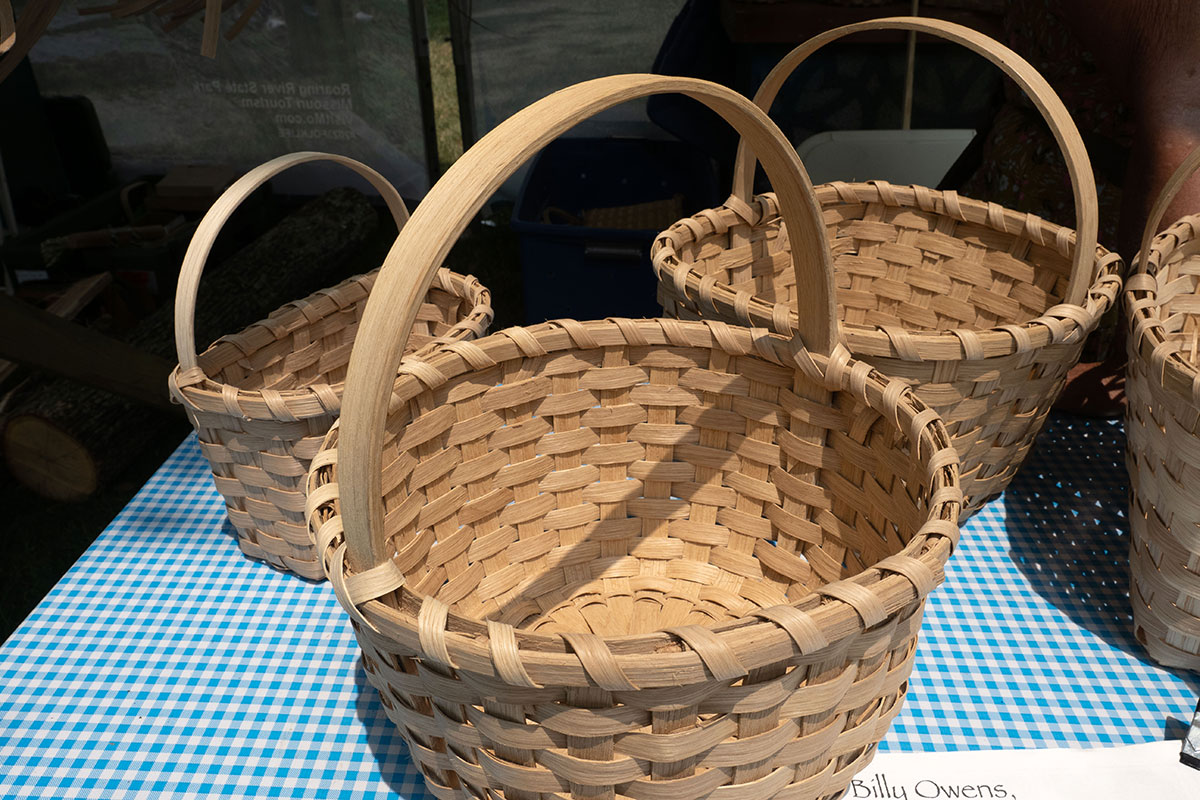White Oak Basketry of the Ozarks: How Trees and Traditions May Fade and Regrow

White oak baskets by Billy Owens on display at the 2023 Smithsonian Folklife Festival.
Photo by Julie Byrne, Ralph Rinzler Folklife Archives
In the Ozarks, white oak basketry is part of a long, proud history of family tradition and respect for nature. The products, woven from wide bands of pale wood, are not only functional but pleasing to the eye. Billy Owens and Aaron Holsapple are two of many basket weavers working to make art and preserve their history along with the land that shaped it. For the 2023 Smithsonian Folklife Festival, they both traveled from Missouri to share their skills and their stories.
Billy Owens, a second-generation basket weaver from Jenkins, Missouri, wears a shirt for the company his dad started: Owens Oak Baskets. “There was family after family after family of basket weavers,” as he explained, who passed their techniques onto the next generation. Owens himself learned from his father and still uses the knowledge he inherited to create his art.
“But when the World War II generation got physically unable to do it, the next generation, the Baby Boomers, found easier and more lucrative ways to make a living,” he continued. “So, none of the families carried it on.” As a result, basket weaving is something of a vanishing practice, and the trees that usually provide wood for the baskets are fading along with it.
Aaron Holsapple, locally known in Jefferson City, Missouri, as “the tree guy” for his tree-to-basket practice, discovered basket making while reading an article. “And I thought, well this might be a fun little project to investigate.” He apprenticed with a couple who had been making baskets for years, learning the different styles that can be made from strips of wood. Holsapple is also a forester, so the use of the white oak trees in Ozark baskets was right up his alley.






According to both men, the act of picking trees is incredibly important. As Owens put it, “There’s no machine way to do it. You go out to the forest. You pick out what you think will work, and sometimes you’re right and sometimes you’re not. The trees determine what you can and cannot make.”
“It all depends on the tree,” Holsapple chimed in. “And every tree is different.”
Both basket makers hold a great deal of respect for white oaks for this very reason: the trees determine their craft. But white oak trees are highly sought after for other uses as well, particularly barrel making.
“You bourbon drinkers are putting us out of a job,” Owens joked.
Holsapple nodded in agreement. “The Ozarks have some of the best barrel materials in the U.S., and I like to say that it’s so good that even the French are coming over and using our Missouri white oak for their barrels. A lot of it is because it grows so slow, which gives it a high mineral content that adds a lot of flavor to whatever you’re going to age.”
This slow growth also means that removing too many trees too quickly can devastate the population for years to come. The Ozarks have seen a decline in white oak trees, making sustainability—already a tenet of traditional basket weaving—more important than ever to Owens and Holsapple.
“We’re not going in there taking everything out,” Owens explained. “You might see a little grove of white oak trees—let’s say there’s fifteen decent looking white oak trees. You’re not going to take fifteen. You’re going to take maybe six or seven of the best and let the others continue to thrive. You’re always leaving nature part of her own stuff, because she will reclaim her stuff if men get too involved.”
The fading of the practice and trees is a real threat, but Holsapple and Owens have attended basket conventions in various states which display different basket-making traditions and often use different materials, and Owens teaches his own workshops back in the Ozarks for enthusiastic learners. Through their work and their demonstrations at the Folklife Festival, both craftsmen share proof that the art form is still rooted and growing.

Eileen Jones is a writing intern at the Center for Folklife and Cultural Heritage. She is a junior at George Washington University where she studies creative writing and American studies.

